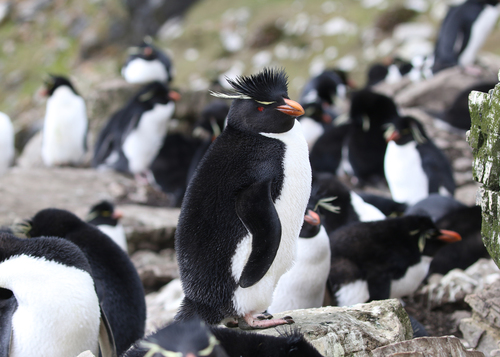
Southern Rockhopper Penguin
The Southern Rockhopper Penguin (*Eudyptes chrysocome*) is a charismatic and easily recognizable penguin species, known for its distinctive yellow crest feathers and red eyes. It plays a vital role in the marine ecosystems of the subantarctic islands where it breeds. Unlike some penguins that slide on their bellies, Rockhoppers hop over rocks, giving them their name. They are culturally significant as a symbol of resilience and adaptability in harsh environments, and are often featured in nature documentaries and educational materials.
45-58 cm
Length
Not applicable (modified into flippers) cm
Wingspan
Vulnerable
Conservation Status
Distribution
Breeds on subantarctic islands in the South Atlantic and Indian Oceans, including the Falkland Islands, South Georgia, and Macquarie Island. Migrates to surrounding waters during the non-breeding season, with some individuals traveling considerable distances.
Lifespan
Typically 10-15 years in the wild, potentially longer in captivity.
Southern Rockhopper Penguin's Habitat
Habitat Types
Rocky coastlines, Coastal cliffs, Subantarctic grasslands
Climate Zones
Subantarctic, Temperate (in some breeding locations)
Adaptations
Dense, waterproof plumage for insulation in cold waters; strong claws for gripping rocks; salt glands to excrete excess salt ingested while feeding.
Variations
Two recognized subspecies: *E. c. chrysocome* (southern) and *E. c. filholi* (eastern). These differ slightly in size and crest morphology.
Appearance
Breeding Plumage
Breeding plumage is more vibrant, with prominent yellow crests. Non-breeding plumage is duller, with less distinct crests.
Seasonal Feather Changes
Undergoes a complete molt annually after breeding, replacing all feathers.
Sex Based Plumage Differences
Males have slightly larger and more elaborate crests.
Notable Features
Bright yellow crest feathers extending from above the eyes, Red eyes, Black, spiky feathers on the head, Stubby, reddish-pink bill
Diet and Feeding
Primary Foods
Krill, Small fish, Squid, Crustaceans
Foraging Behavior
Pursuit divers, diving to depths of up to 100 meters to catch prey. Forage in groups, often traveling long distances from breeding colonies.
Specializations
Streamlined body and powerful flippers for efficient underwater swimming.
Seasonal Diet Variations
Diet composition varies depending on prey availability, which can fluctuate seasonally and geographically.
Behavior
Social Structure
Highly social, breeding in large, dense colonies. Forms smaller groups during the non-breeding season.
Communication
Loud, braying calls, Visual displays (head and flipper movements), Mutual preening
Migration
Disperses widely after breeding, but specific migration routes are not fully understood. Some populations may be relatively sedentary.
Territorial or Group Behaviors
Highly territorial during breeding, defending small nesting sites. Aggressive interactions, including pecking and flipper-slapping, are common.
Conservation
Threats
Climate change (affecting prey availability), Commercial fishing (competition for food and bycatch), Oil spills and pollution, Introduced predators (rats, cats) on some breeding islands, Human disturbance
Protection Programs
CITES Appendix I (prohibits international trade), Marine Protected Areas around some breeding colonies, Research and monitoring programs
Local National Laws
Protected under national legislation in several countries, including Argentina, Chile, and Australia.
Population Trend
Decreasing
Population Estimates
Estimated at around 1 million breeding pairs, but significant declines have been observed in recent decades.
Interesting Facts
They are one of the smallest crested penguin species.
Their small size allows them to navigate the rocky terrain of their breeding colonies.
They can porpoise out of the water.
This leaping behavior, similar to dolphins, helps them to breathe while swimming quickly and to avoid predators.
They can hold their breath for several minutes.
This adaptation allows them to dive deep in search of food.
The name "rockhopper" comes from their habit of hopping over rocks.
Unlike other penguins that may slide on their bellies, rockhoppers prefer to hop, even on challenging terrain.
Faqs about Southern Rockhopper Penguin
Are Southern Rockhopper Penguins endangered?
They are classified as Vulnerable by the IUCN, meaning they face a high risk of extinction in the wild.
What eats Southern Rockhopper Penguins?
Predators include leopard seals, fur seals, sea lions, and skuas (which prey on eggs and chicks).
How deep can Southern Rockhopper Penguins dive?
They can dive up to 100 meters (330 feet), but typically forage at shallower depths.
Do both parents take care of the chicks?
Yes, both the male and female Southern Rockhopper Penguin share the responsibilities of incubating the eggs and feeding the chicks.
How can I help Southern Rockhopper Penguins?
Support organizations dedicated to penguin conservation, reduce your carbon footprint to combat climate change, and advocate for sustainable fishing practices.
Copyright @ Nature Style Limited. All Rights Reserved.
 English
English